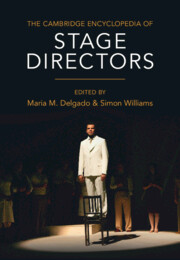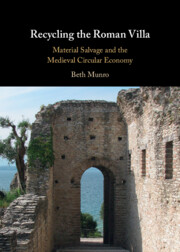Refine search
Actions for selected content:
26 results
‘Female Genital Schistosomiasis: Translational Challenges and Opportunities’ – outputs and actions from a consultative, collaborative and translational workshop
-
- Journal:
- Parasitology , First View
- Published online by Cambridge University Press:
- 23 June 2025, pp. 1-11
-
- Article
-
- You have access
- Open access
- HTML
- Export citation

The Cambridge Encyclopedia of Stage Directors
-
- Published online:
- 19 June 2025
- Print publication:
- 03 July 2025
5 - The Arrests Begin
- from Part III - Conspiracy Arrested
-
- Book:
- Seditious Spaces
- Published online:
- 06 March 2025
- Print publication:
- 13 March 2025, pp 141-175
-
- Chapter
- Export citation

Recycling the Roman Villa
- Material Salvage and the Medieval Circular Economy
-
- Published online:
- 08 November 2024
- Print publication:
- 31 October 2024
10 - Composing for the Stage
- from Part II - Techniques
-
-
- Book:
- The Cambridge Companion to Composition
- Published online:
- 25 May 2024
- Print publication:
- 30 May 2024, pp 153-163
-
- Chapter
- Export citation
Evaluating a web-based guide for designing digital patient experiences: preliminary results of a user test with design students
-
- Journal:
- Proceedings of the Design Society / Volume 4 / May 2024
- Published online by Cambridge University Press:
- 16 May 2024, pp. 1687-1696
-
- Article
-
- You have access
- Open access
- Export citation
Evaluation of an intensive workshop on research methods in supportive oncology
-
- Journal:
- Palliative & Supportive Care / Volume 22 / Issue 4 / August 2024
- Published online by Cambridge University Press:
- 22 March 2023, pp. 649-654
-
- Article
-
- You have access
- Open access
- HTML
- Export citation
In-person 1-day cognitive behavioral therapy-based workshops for postpartum depression: a randomized controlled trial
-
- Journal:
- Psychological Medicine / Volume 53 / Issue 14 / October 2023
- Published online by Cambridge University Press:
- 07 March 2023, pp. 6888-6898
-
- Article
-
- You have access
- Open access
- HTML
- Export citation
12 - Presenting Your Research
- from Part III - Your Research/Academic Career
-
-
- Book:
- The Portable Mentor
- Published online:
- 21 July 2022
- Print publication:
- 04 August 2022, pp 217-234
-
- Chapter
-
- You have access
- Open access
- HTML
- Export citation
19 - Lessons Learned on Resilience from a Multi-scale Co-creation Methodology
-
-
- Book:
- Resilient and Sustainable Farming Systems in Europe
- Published online:
- 21 April 2022
- Print publication:
- 05 May 2022, pp 321-341
-
- Chapter
-
- You have access
- Open access
- HTML
- Export citation
What should be measured to assess the quality of community-based palliative care? Results from a collaborative expert workshop
-
- Journal:
- Palliative & Supportive Care / Volume 20 / Issue 2 / April 2022
- Published online by Cambridge University Press:
- 22 June 2021, pp. 226-232
-
- Article
- Export citation
5 - ‘Rehabilitation’ through Work?
- from Part II - Reconstructing the Body, Rehabilitating the Mind?
-
- Book:
- Reinventing French Aid
- Published online:
- 20 May 2021
- Print publication:
- 20 May 2021, pp 248-292
-
- Chapter
- Export citation
A textile workshop to approach Classical civilisation
-
- Journal:
- Journal of Classics Teaching / Volume 22 / Issue 43 / Spring 2021
- Published online by Cambridge University Press:
- 23 March 2021, pp. 55-59
-
- Article
-
- You have access
- Open access
- HTML
- Export citation
Industrial disability in the Japanese railways business: the activity of Testudō Kōsaikai, 1931–1955
-
- Journal:
- International Journal of Asian Studies / Volume 19 / Issue 1 / January 2022
- Published online by Cambridge University Press:
- 12 March 2021, pp. 19-35
-
- Article
- Export citation
Nick Martin and the ‘Boulder Workshops’
-
- Journal:
- Twin Research and Human Genetics / Volume 23 / Issue 2 / April 2020
- Published online by Cambridge University Press:
- 19 May 2020, pp. 80-81
-
- Article
-
- You have access
- HTML
- Export citation
Cultural safety training for allied health students in Australia
-
- Journal:
- The Australian Journal of Indigenous Education / Volume 50 / Issue 2 / December 2021
- Published online by Cambridge University Press:
- 30 April 2020, pp. 274-283
- Print publication:
- December 2021
-
- Article
- Export citation
Attitudes towards the dying and death anxiety in acute care nurses – can a workshop make any difference? A mixed-methods evaluation
-
- Journal:
- Palliative & Supportive Care / Volume 18 / Issue 2 / April 2020
- Published online by Cambridge University Press:
- 06 August 2019, pp. 164-169
-
- Article
- Export citation
Developing a team science workshop for early-career investigators
-
- Journal:
- Journal of Clinical and Translational Science / Volume 3 / Issue 4 / August 2019
- Published online by Cambridge University Press:
- 29 July 2019, pp. 184-189
-
- Article
-
- You have access
- Open access
- HTML
- Export citation
Testing the Robustness of Circularity Indicators: Empirical Insights from Workshops on an Industrial Product
- Part of
-
- Journal:
- Proceedings of the Design Society: International Conference on Engineering Design / Volume 1 / Issue 1 / July 2019
- Published online by Cambridge University Press:
- 26 July 2019, pp. 3401-3410
- Print publication:
- July 2019
-
- Article
-
- You have access
- Open access
- Export citation
Building Partnerships and Bridging Science and Policy to Address the Biological Invasions Crisis
-
- Journal:
- Invasive Plant Science and Management / Volume 12 / Issue 1 / March 2019
- Published online by Cambridge University Press:
- 13 February 2019, pp. 74-78
-
- Article
- Export citation
